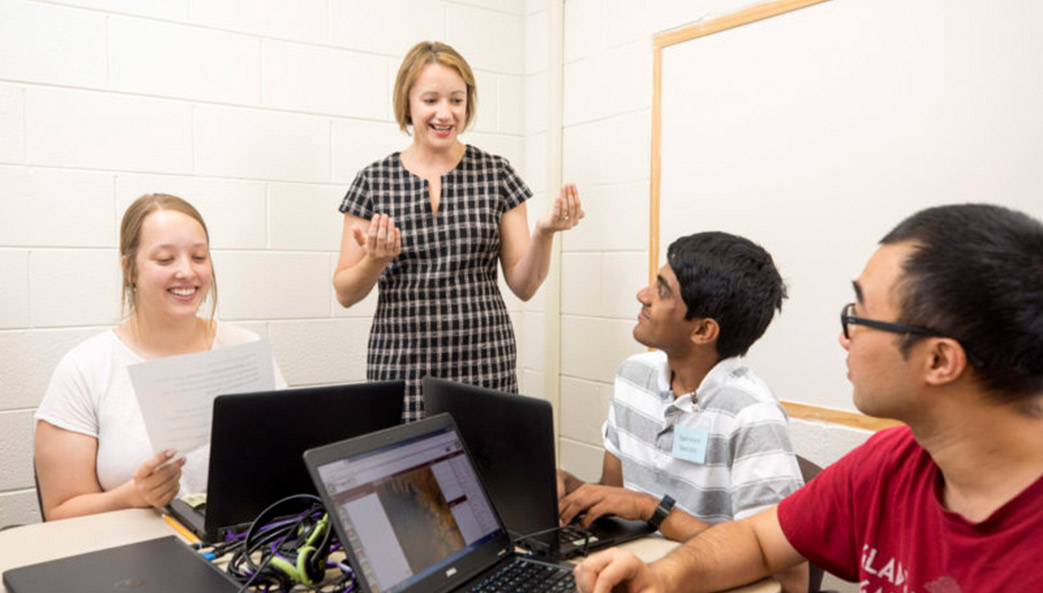How fathers, children should spend time together
Study dives into factors that could help develop a stronger relationship
Researchers use technology to predict schizophrenia
New technology-based tools will catch negative symptoms associated with schizophrenia
Would you rather get $50 today or $100 next year?
Research digs into the reasoning and decision-making for “hyperbolic discounting”
Research shows it pays to practice gratitude
A study found that feelings of gratitude boosted marital satisfaction, commitment and stability, especially during difficult times.
Causes of work, family stress for same-sex couples
Hiding sexuality at work creates tension for partners
Narcissistic individuals use social media to self-promote
Meta-analysis by UGA psychology researchers suggests how social media use correlates with narcissism.
Study challenges theory that good communication leads to marital satisfaction
One of the top reasons couples seek counseling is communication issues, so does better communication predict a more satisfying relationship? The answer may not be that simple, according to a study by UGA researchers.
Not so narcissistic
May 10, 2016
Narcissists tend to be insufferable. They are self-absorbed, have an inflated view of their own talents, crave attention and admiration, and are extremely selfish.
Thus it’s distressing that Americans are typically perceived as narcissistic—even thought likely to meet the diagnostic criteria for the psychiatric disorder—
according to a study conducted by UGA psychologists in collaboration with colleagues from around the world.
The reality is that in most epidemiological surveys fewer than one in 100 individuals meet the diagnostic criteria for the narcissistic personality disorder, marking it as a relatively rare disorder—whether in the United States or elsewhere.
The study indicates that the perception of American narcissism is far worse than the actual incidence. “We might have a narcissistic culture,” said Keith Campbell, study coauthor and head of the Department of Psychology, “but the people themselves aren’t necessarily narcissistic.”

Keith Campbell is the head of UGA’s Department of Psychology.
Researchers identify key biological markers for psychotic disorders
By James Hataway
A team of researchers led by faculty at the University of Georgia has identified a number of biological markers that make it possible to classify mental disorders with greater precision. Their findings, published today in the American Journal of Psychiatry, may one day lead to improved diagnostics and treatments for those suffering from mental illness.
The advent of modern medical diagnostic tools has made it possible to identify the hallmarks of innumerable diseases with simple, reliable tests that portray the inner workings of the body in exquisite detail—allowing doctors to pinpoint the specific cause of a patient’s complaint and prescribe the proper course of treatment.
The same cannot be said, however, for the field of psychiatry. Despite advances in technology, there are no objective medical tests to diagnose mental disorders. Psychiatrists cannot find evidence of schizophrenia in a blood sample; they can’t see bipolar disorder in an X-ray.
“Psychiatry still relies on symptoms as the basis of a diagnosis,” said the study’s lead author Brett Clementz, a professor of psychology in UGA’s Franklin College of Arts and Sciences. “It would be like using the presence of fever to diagnose a specific infection. We need some means to help us more accurately differentiate mental disorders.”
To that end, Clementz and his colleagues created an experimental program that uses neurobiological measures rather than symptoms to identify disease types. They focused exclusively on patients suffering from psychosis—a broad category of mental disorder that includes schizophrenia, schizoaffective disorder and bipolar disorder with psychosis—to see if they could improve upon existing methods.
Mental health professionals traditionally use criteria outlined in the Diagnostic and Statistical Manual of Mental Disorders, or DSM, to identify specific mental disorders based on observable symptoms, which, in the case of psychosis, may include hallucinations, delusions, radical changes in personality or a distorted sense of reality.
“We wanted to try to provide neurobiological underpinnings for DSM-type psychosis diagnoses,” Clementz said.
The research team recruited more than 700 patients with psychosis and some of their first-degree relatives—a parent, sibling or child—as well as a control group of healthy individuals to see if they could identify brain-based diagnostic markers to differentiate these conditions.
Each participant went through a battery of tests designed to assess their cognitive abilities, including MRI scans and specially designed examinations that asked participants to respond to simple visual or auditory cues, which reveal sensory and perceptual abnormalities.
Researchers used these measures to identify different “biotypes” of mental disorders, which proved to be superior to DSM standards.
“We were better able to predict who had family histories of psychoses, structural brain abnormalities and measures of social functioning when compared with DSM standards,” Clementz said.
In addition to finding more accurate ways of categorizing disease types, the researchers hope that this project may inspire a renewed interest in psychiatric drug development, which has been stymied recently by a lack of clear biological targets.
“Psychiatry has relied mostly on serendipity for new drugs,” Clementz said. “All of the medications that we use for psychosis have mostly the same mechanism of action, and there are no unique treatments for the various diagnoses.
“You can’t, for example, use an animal model for schizophrenia. How do you find a schizophrenic mouse? But if we can identify a biological mechanism that contributes to disease, then we may reinvigorate drug development, and that’s what we’re trying to provide.”
Clementz is quick to caution that there is still much work to be done before these measures could be used for new diagnostics or to measure drug efficacy, but he is hopeful that this work will lead to much needed advances in the field.
“We’re a long way from identifying specific disease mechanisms, but we’re a step closer than we were when we focused on clinical symptoms alone,” he said.
The project is part of the Bipolar Schizophrenia Network on Intermediate Phenotypes, or BSNIP, a large-scale study designed to discover how risk for schizophrenia and bipolar disorder is transmitted in families and to evaluate risk factors for these diseases.
Research in this news release was supported in part by National Institute of Mental Health grants MH-077851, MH-078113, MH-077945, MH- 077852 and MH-077862.
The study, “Identification of Distinct Psychosis Biotypes Using Brain-Based Biomarkers,” is available at http://ajp.psychiatryonline.org/doi/abs/10.1176/appi.ajp.2015.14091200.
Researchers develop visual test to quickly evaluate brain function
By Sydney Devine
University of Georgia researchers have developed a simple technique to measure an individual’s visual processing speed—the speed at which an individual can comprehend visual information—in order to identify whether or not they may have cognitive issues.
The recent study, published in the journal Archives of Clinical Neuropsychology, focuses on using a simple test of visual flicker to evaluate an individual’s level of executive cognitive abilities, such as shifting attention between different tasks, planning or organizing and problem solving.
For this study, researchers from UGA’s Neuropsychology and Memory Assessment Laboratory and Vision Sciences Laboratory collaborated to use a method based on measuring processing speed through sight. Catherine Mewborn, a doctoral candidate in UGA’s Franklin College of Arts and Sciences department of psychology, led the study.
“We knew that sensory function is important for cognitive function, and we had a unique opportunity with this collaboration,” said Mewborn, who works in the Neuropsychology and Memory Assessment Laboratory under the mentorship of L. Stephen Miller.
The device they used tests processing speed by measuring an individual’s critical flicker fusion.
Participants in the study looked into a device that was created for the purpose of this study. Inside the device, two wavelengths of light would alternate flashing, making it seem as though the light they were looking at was flickering on and off.
“The flickering starts out very slowly, and almost everyone can see that,” Mewborn said. “During the test, the frequency of the flickering light would change, becoming faster. It’d continue to speed up and eventually go so fast that at some point the flickering can’t be seen anymore, and it just looks like a solid circle of light.”
A participant’s critical flicker fusion measure tops out when the flicker is too fast for the participant to see.
“The point at which you stop seeing the flickering is different for everyone,” Mewborn said.
This flicker measure predicted participants’ executive cognitive functioning. Individuals with higher critical flicker fusion also had higher executive functioning.
Researchers also found that results varied based on a participant’s age. They tested two age groups-college students, averaging 21 years, and older adults, averaging 72 years.
Generally, the older participants had slower visual processing speed, which researchers expected as older adults typically process information more slowly.
What separates this study from others is the simplicity and accuracy of the flicker measurements, Mewborn said. Critical flicker fusion may tap more basic cognitive processes than other tests traditionally used by researchers.
“One technique for measuring cognitive function is to use a standard paper-and-pencil task. The approach that we wanted to investigate, however, was to measure the ‘fundamentals’ of cognition,” said study co-author Billy Hammond, a UGA professor of brain and behavioral sciences in the department of psychology and director of the Vision Sciences Laboratory.
The brain, not the eye, determines the fastest visual flicker that can be perceived. By measuring critical flicker speeds researchers are able to assess the processing speed of the brain itself, which forms the basis of many higher cognitive functions, such as fluency or memory.
“If I wanted to know something about your cognition in relation to your risks for dementia, I’d have to give a very long test or an MRI. But if you can test for dementia by testing visual processing speed, that’s very easy and quick,” he said.
“We used a method that didn’t have a lot of the past limitations of other studies, and it could measure this speed much more accurately. If I show you a flickering light, and it flickers faster and faster, until it doesn’t flicker, that is pretty objective, with a lot less variability.”
Although this study is still in early stages, it may change the process of future exams when testing for dementia and other cognitive issues.
“The next step would be to look at these same sorts of tasks and see whether or not it could predict individuals who are beginning to show early signs of cognitive impairment, such as early signs of Alzheimer’s disease,” Mewborn said.
Sensory function—the extent to which an individual correctly senses, hears, tastes, smells and/or sees something—is important for overall brain and memory function. To be able to quickly identify someone’s level of visual processing speed, especially in aging individuals, could flag who might have greater cognitive difficulties, she said.
An additional study co-author is Lisa Renzi, a part-time clinical assistant professor at UGA’s department of psychology.
The study, “Critical Flicker Fusion Predicts Executive Function in Younger and Older Adults,” is available online at http://acn.oxfordjournals.org/content/early/2015/09/13/arclin.acv054.full.
New clues about how humans become tool users
New research from the University of Georgia department of psychology gives researchers a unique glimpse at how humans develop an ability to use tools in childhood while nonhuman primates—such as capuchin monkeys and chimpanzees—remain only occasional tool users.
Dorothy Fragaszy, a psychology professor in the Franklin College of Arts and Sciences and director of the Primate Behavior Laboratory at UGA, created two studies to look at how nonhuman primates and human children differ in completing simple spatial reasoning tasks.
Much like a game of Operation, human children ages 2, 3 and 4 and adult nonhuman primates were asked to fit a stick, a cross and a tomahawk into a matching cutout space on a tray. Children were also given an opportunity to complete this task by placing the sticks on a mat with a drawing of the matching shape, as well as into a space on a tray.
“We did the study with nonhuman primates specifically to look at the management of objects in space,” Fragaszy said. “I wanted to give them a spatial reasoning task that was not a tool-using task. We wanted to look at how they worked with these objects and arranged them in relation to features of another surface and from that gain some insight as to how they use objects as tools.
“In the case of the children, we wanted to see how they completed the same spatial reasoning task, but with a developmental dimension to it that is not present with our study of nonhuman primates because they were all adults.”
What they found, she said, was a clear age effect in the children. Two-year-olds were able to fit the straight stick and the cross-shaped stick properly into the cutout most of the time. Three- and 4-year-olds were even better at it. However, when it came time to fit the tomahawk stick into the cutout, 2-year-olds were unable to complete the task most of the time, while 3- and 4-year-olds were also challenged.
Children were adept at using sight to help figure out how an object should be aligned to fit it into the space. Sometimes some of the 3- and 4-year-olds would hold the object, especially the cross or tomahawk stick, a little bit above the tray and move it in the air as if they were aligning it visually before they put it down.
Instead of depending on sight, nonhuman primates often used their sense of touch, known as their haptic senses, to feel how the object fit into the space.
“Adult chimps and capuchin monkeys are among the most accomplished spatial problem solvers among the nonhuman primates, but even the 2-year-olds are much better than they are at alignment,” Fragaszy said.
Between 16-18 months and 2 years, humans develop a new relationship between vision and action. Prior to this development, they have trouble orienting another object that’s not their own body in space.
When asked to complete the task in a two-dimensional version that involved visually aligning an object in the correct place, children were less successful and made fewer attempts than with the three-dimensional tasks.
“This makes sense if you think about the contribution of haptic perception to what’s going on,” Fragaszy said. “You can feel when a three-dimensional object hits the edge of a cutout. You don’t feel anything with a flat two-dimensional object such as a disk. It indicates again that vision is not enough for young children. The haptic component is also helpful for them. For nonhuman primates, the haptic component is essential.”
Humans use what’s known as a vision for action system. Visual information is integrated into planning action and guiding movements of the body in space, especially to use the hands to reach for and grasp objects and manipulate them in space. Researchers have studied what happens if part of that system doesn’t work very well, but researchers haven’t known much about how that system develops until now.
“People have thought for a long time about what makes tool use difficult for nonhuman primates and easy for humans, but they haven’t thought about it in this way,” she said. “I’m hopeful that this will generate further research on this, both with humans and nonhuman primates, to clarify the answer to this question.”
The study, “‘Vision for Action’ in Young Children Aligning Multi-Featured Objects: Development and Comparison with Nonhuman Primates,” appears in the journal PLOS ONE and can be viewed at http://journals.plos.org/plosone/article?id=10.1371/journal.pone.0140033.

Dorothy Fragaszy is a psychology professor in the Franklin College of Arts and Sciences and director of the Primate Behavior Laboratory at UGA.
Rates of narcissism lower than national perception
By Alan Flurry
Americans consistently reported a perception of the typical U.S. citizen as highly narcissistic—even meeting diagnostic criteria for the psychiatric disorder, according to studies conducted by University of Georgia psychologists in collaboration with colleagues from around the world.
The reality is that fewer than one in 100 individuals meets the diagnostic criteria for the narcissistic personality disorder in most epidemiological surveys, marking it as a relatively rare disorder.
Narcissism is associated with excessive interest in oneself and one’s appearance and ranges from self-confidence to extreme selfishness, with a grandiose view of one’s own talents, self-absorption and a desire for attention and admiration.
The study, “Narcissism and United States’ Culture: The View from Home and Around the World,” was published in September in the early online edition of Journal of Personality and Social Psychology.
The published research represents six studies that include surveys of American college students, American adults and participants from around the world about their perception of Americans. Two of the studies include data from citizens of other world regions (Basque Country, China, England and Turkey), in which citizens were asked to rate citizens of their own regions, as well as from the U.S.
Data from international samples indicated some general tendency to rate the citizens of one’s country or region as more narcissistic than acquaintances or oneself—that is, these finding were not specific to America. However, the differences in these ratings (self versus citizens in general) were smaller in other countries than they were in the U.S., meaning these perceptions are particularly elevated in America.
Although non-Americans from many other parts of the world viewed the typical American as highly narcissistic, they did not cast U.S. citizens in a purely negative light.
“They also said Americans are less neurotic, as well as more extroverted and conscientious, so it wasn’t just an indiscriminant criticism of Americans,” said study co-author Joshua Miller, a professor and director of the clinical training program in the UGA Franklin College of Arts and Sciences’ department of psychology. “It was a specific profile of traits that just happens to be very consistent with what we call grandiose narcissism-these sort of hyper confident, aggressive, assertive individuals.”
In fact, Americans in the surveys held harsher opinions of their fellow citizens. The profile Americans hold of the typical American was more uniformly negative. The researchers posit these perceptions may, in part, be the results of an emphasis on celebrity culture and the rapidly growing influence and role of social media.
“We are inundated with images and information about people from groups who tend to score higher on narcissism,” Miller said. “That doesn’t mean all celebrities are narcissistic. Some may be, and we might incorrectly assume others are on the information available to us in the public domain.”
Evidence indicates the perception of American narcissism is worse than the actual incidence—and skewed by the fact that, in the survey, respondents considered a limited array of people.
“People likely don’t think of their 320 million fellow citizens who live in this country when completing these ratings but of particularly salient examples who may well be narcissistic—and they are extroverted, perhaps over-exposed, and that is reflected in these perceptions,” Miller said.
One of the studies demonstrated that Americans did not uniformly see all Americans as equally narcissistic when given specific exemplars to rate. Instead, research participants rated younger Americans, male Americans and Americans in highly visible and high-status occupations (such as athletes and politicians) as particularly narcissistic.
“It’s interesting that the perception of the typical person, which is essentially a measure of the culture, is so much more narcissistic than the actual people in the culture,” said study co-author Keith Campbell, a professor and head of the department of psychology. “We might have a narcissistic culture, but the people aren’t necessarily all narcissistic.”
The researchers agreed that much in the profile of Americans held by Americans and non-Americans alike was not necessarily indicative of general psychopathology. Instead, the perception was relatively narrow and specific in its focus on narcissism.
“Americans are not viewed as pathologically retreating, submissive or shy. It’s the tendency to act out, externalizing blame and consume more resources than you deserve that is specifically seen as a defining characteristic of Americans,” Miller said.
“The bad news is everyone else in the world agrees. And there’s consensus with the world, so we have this very interesting bias for how we see ourselves as a culture,” Campbell said.
“But the silver lining is we’re not as bad as we think.”
The study’s abstract is available online at http://psycnet.apa.org/psycinfo/2015-43587-001/













